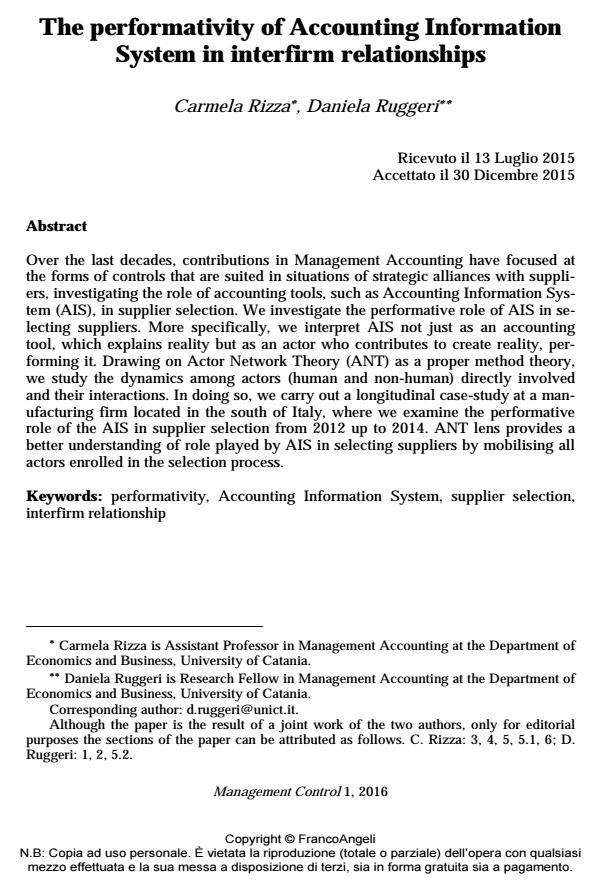The performativity of Accounting Information System in interfirm relationships
Journal title MANAGEMENT CONTROL
Author/s Carmela Rizza, Daniela Ruggeri
Publishing Year 2016 Issue 2016/1
Language English Pages 19 P. 71-89 File size 74 KB
DOI 10.3280/MACO2016-001005
DOI is like a bar code for intellectual property: to have more infomation
click here
Below, you can see the article first page
If you want to buy this article in PDF format, you can do it, following the instructions to buy download credits

FrancoAngeli is member of Publishers International Linking Association, Inc (PILA), a not-for-profit association which run the CrossRef service enabling links to and from online scholarly content.
Over the last decades, contributions in Management Accounting have focused at the forms of controls that are suited in situations of strategic alliances with suppliers, investigating the role of accounting tools, such as Accounting Information System (AIS), in supplier selection. We investigate the performative role of AIS in selecting suppliers. More specifically, we interpret AIS not just as an accounting tool, which explains reality but as an actor who contributes to create reality, performing it. Drawing on Actor Network Theory (ANT) as a proper method theory, we study the dynamics among actors (human and non-human) directly involved and their interactions. In doing so, we carry out a longitudinal case-study at a manufacturing firm located in the south of Italy, where we examine the performative role of the AIS in supplier selection from 2012 up to 2014. ANT lens provides a better understanding of role played by AIS in selecting suppliers by mobilising all actors enrolled in the selection process.
Keywords: Performativity, Accounting Information System, supplier selection, interfirm relationship
- La Network Governance a supporto dell'Open Innovation: un'analisi della letteratura Palmira Piedepalumbo, Concetta Metallo, Daniela Mancini, in MANAGEMENT CONTROL 3/2017 pp.79
DOI: 10.3280/MACO2017-003006 - Capacity building nelle organizzazioni nonprofit: come le fondazioni d'erogazione rinforzano i propri beneficiari Andrea Bafundi, Giacomo Boesso, Fabrizio Cerbioni, in MANAGEMENT CONTROL 2/2025 pp.39
DOI: 10.3280/MACO2025-002003 - The entangled relationships between accounting information systems innovations and corporate governance dynamics: a performative perspective Carmela Rizza, Daniela Ruggeri, in Journal of Management and Governance /2025 pp.1083
DOI: 10.1007/s10997-025-09762-y
Carmela Rizza, Daniela Ruggeri, The performativity of Accounting Information System in interfirm relationships in "MANAGEMENT CONTROL" 1/2016, pp 71-89, DOI: 10.3280/MACO2016-001005